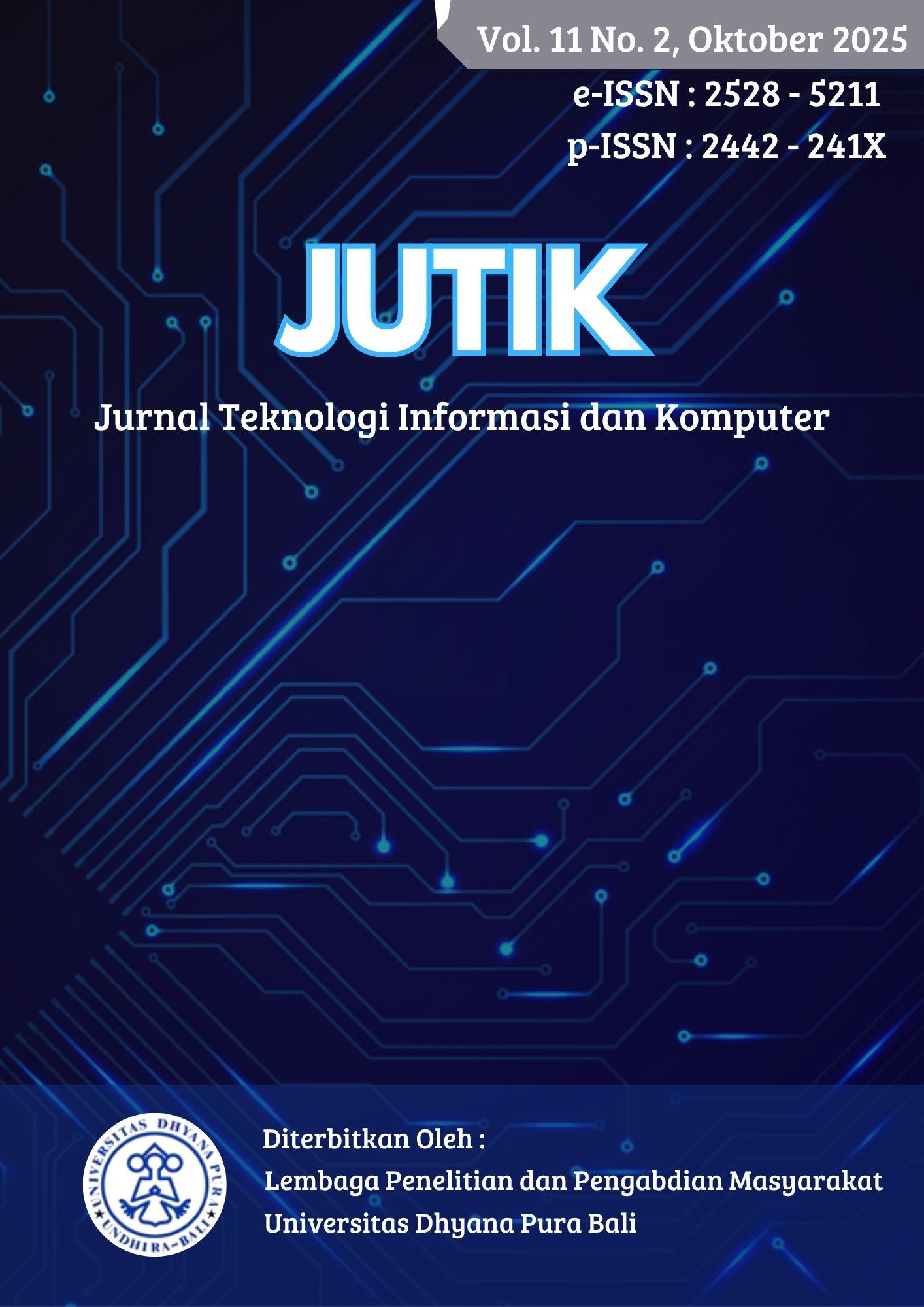ANALISIS PENERIMAAN OPENAI CHATGPT OLEH MAHASISWA SURABAYA MENGGUNAKAN MODEL UTAUT 2
DOI:
https://doi.org/10.36002/jutik.v11i2.3981Keywords:
ChatGPT, higher education, technology acceptance, university students, UTAUT 2Abstract
This study uses the Unified Theory of Acceptance and Use of Technology 2 (UTAUT 2) model to investigate and analyze the factors that may influence Surabaya university students in accepting and using ChatGPT. Data collection was conducted by conducting a questionnaire survey of 119 student respondents was used to collect data and Partial Least Squares - Structural Equation Modeling (PLS-SEM) was used to process the data. The findings show that the most important predictors of intention and behavior of using ChatGPT are habit and conducive circumstances. On the other hand, behavioral intentions were not significantly influenced by other factors including hedonic motivation, social influence, or performance expectations. These results suggest that ChatGPT adoption patterns have changed from initial impressions of ease of use or technological advantages to being based on routine and infrastructure support.
References
[1] M. Rafli, “Indeks Pembangunan TIK Indonesia Kembali Meningkat,” GoodStats. Accessed: Mar. 11, 2025. [Online]. Available: https://data.goodstats.id/statistic/indeks-pembangunan-tik-indonesia-kembali-meningkat-RnbEG
[2] D. Menon and K. Shilpa, “‘Chatting with ChatGPT’: Analyzing the factors influencing users’ intention to Use the Open AI’s ChatGPT using the UTAUT model,” Heliyon, vol. 9, no. 11, pp. 1–19, Nov. 2023, doi: 10.1016/j.heliyon.2023.e20962.
[3] M. S. Maulana, Nurmalasari, S. R. Widianto, S. D. A. Safitri, and R. Maulana, “Pelatihan Chat GPT Sebagai Alat Pembelajaran Berbasis Artificial Intelligence di kelas,” JOTIKA: Jurnal Penelitian dan Pengabdian Masyarakat Jotika, vol. 3, no. 1, pp. 16–19, Aug. 2023, doi: 10.31004/edukatif.v5i1.4779.
[4] I. Alfarobi, S. Wira Hadi, A. Nur Rais, and W. Kurniawan, “Analisa Penerimaan Tekhnologi Artificial Intelligence Generative Dengan Menggunakan Metode UTAUT 2,” KESATRIA: Jurnal Penerapan Sistem Informasi (Komputer & Manajemen), vol. 5, no. 1, pp. 195–201, 2024.
[5] E. S. Almetere, B. W. Y. Kelana, and N. N. A. Mansor, “Using UTAUT Model to Determine Factors Affecting Internet of Things Acceptance in Public Universities,” International Journal of Academic Research in Business and Social Sciences, vol. 10, no. 2, pp. 142–150, Feb. 2020, doi: 10.6007/ijarbss/v10-i2/6915.
[6] P. N. Ardiyani, Y. Rahardja, and J. J. Tambotoh, “Analisis Penerimaan Learning Management System Menggunakan Model UTAUT 2 Pada Universitas Tadulako,” Jurnal Teknik Informatika dan Sistem Informasi, vol. 10, no. 1, pp. 157–171, 2023, doi: 10.35957/jatisi.v10i1.2523.
[7] K. Tamilmani, N. P. Rana, S. F. Wamba, and R. Dwivedi, “The extended Unified Theory of Acceptance and Use of Technology (UTAUT2): A systematic literature review and theory evaluation,” Int J Inf Manage, vol. 57, Apr. 2021, doi: 10.1016/j.ijinfomgt.2020.102269.
[8] L. A. Galantry and A. R. Tanaamah, “Analisis Adopsi ChatGPT menggunakan Model UTAUT,” Sistemasi: Jurnal Sistem Informasi, vol. 13, pp. 1216–1225, 2024, doi: 10.32520/stmsi.v13i3.4124.
[9] I. N. Y. A. Wijaya and I. P. K. Negara, “Analisis Pengaruh Penerimaan Pengguna E-Learning (Schoology) Pada Mahasiswa Menggunakan Metode TAM (Studi Kasus STMIK Primakara),” Jurnal Teknologi Informasi dan Komputer, vol. 7, pp. 54–62, 2021, doi: 10.36002/jutik.v7i1.1298.
[10] Sugiyono, Metode Penelitian Kuantitatif, Kualitatif, dan R&D, 2nd ed. Bandung: Alfabeta, 2020.
[11] B. L. Handoko, “Pendekatan Lemeshow untuk Penentuan Sampel pada Populasi yang Tidak Diketahui,” Binus University. Accessed: Apr. 13, 2025. [Online]. Available: https://accounting.binus.ac.id/2024/10/23/pendekatan-lemeshow-untuk-penentuan-sampel-pada-populasi-yang-tidak-diketahui/
[12] Maidiana, “Penelitian Survey,” ALACRITY: Journal Of Education, vol. 1, no. 2, pp. 20–29, 2021, doi: 10.52121/alacrity.v1i2.23.
[13] A. Pratita, T. L. M. Suryanto, A. Pratama, and A. Wibowo, “ChatGPT in Education: Investigating Students Online Learning Behaviors,” International Journal of Information and Education Technology, vol. 15, no. 3, pp. 510–524, 2025, doi: 10.18178/ijiet.2025.15.3.2262.
[14] C. Amanda, H. Suyono, and A. M. Diponegoro, “Uji Validitas dan Reliabilitas Konstruk Dukungan Sosial Menggunakan SEM,” Psyche 165 Journal, vol. 13, no. 02, 2020, doi: 10.35134/jpsy165.v13i2.81.
[15] Y. Aryani and D. Gustian, “Sistem Informasi Penjualan Barang dengan Metode Regresi Linear Berganda dalam Prediksi Pendapatan Perusahaan,” JURSISTEKNI: Jurnal Sistem Informasi dan Teknologi Informasi, vol. 2, no. 2, pp. 39–51, 2020, doi: 10.52005/jursistekni.v2i2.47.
[16] A. Lithasari, M. Suparmoko, and A. Mukhlis, “The Role of Collaborative Attitude towards Commitment through Mediation of Life Satisfaction and Emotional Behavior (Empirical Study on Non-ASN Teachers in Cilegon City),” in Seminar Nasional Inovasi Pendidikan Ke-7 (SNIP 2023), Universitas Sebelas Maret, 2023, pp. 470–480. doi: 10.20961/shes.v6i4.82663.
Downloads
Published
How to Cite
Issue
Section
License
Copyright (c) 2025 Jurnal Teknologi Informasi dan Komputer

This work is licensed under a Creative Commons Attribution-NonCommercial-ShareAlike 4.0 International License.
![]()
This work is licensed under a Creative Commons Attribution-NonCommercial-ShareAlike 4.0 International License.











